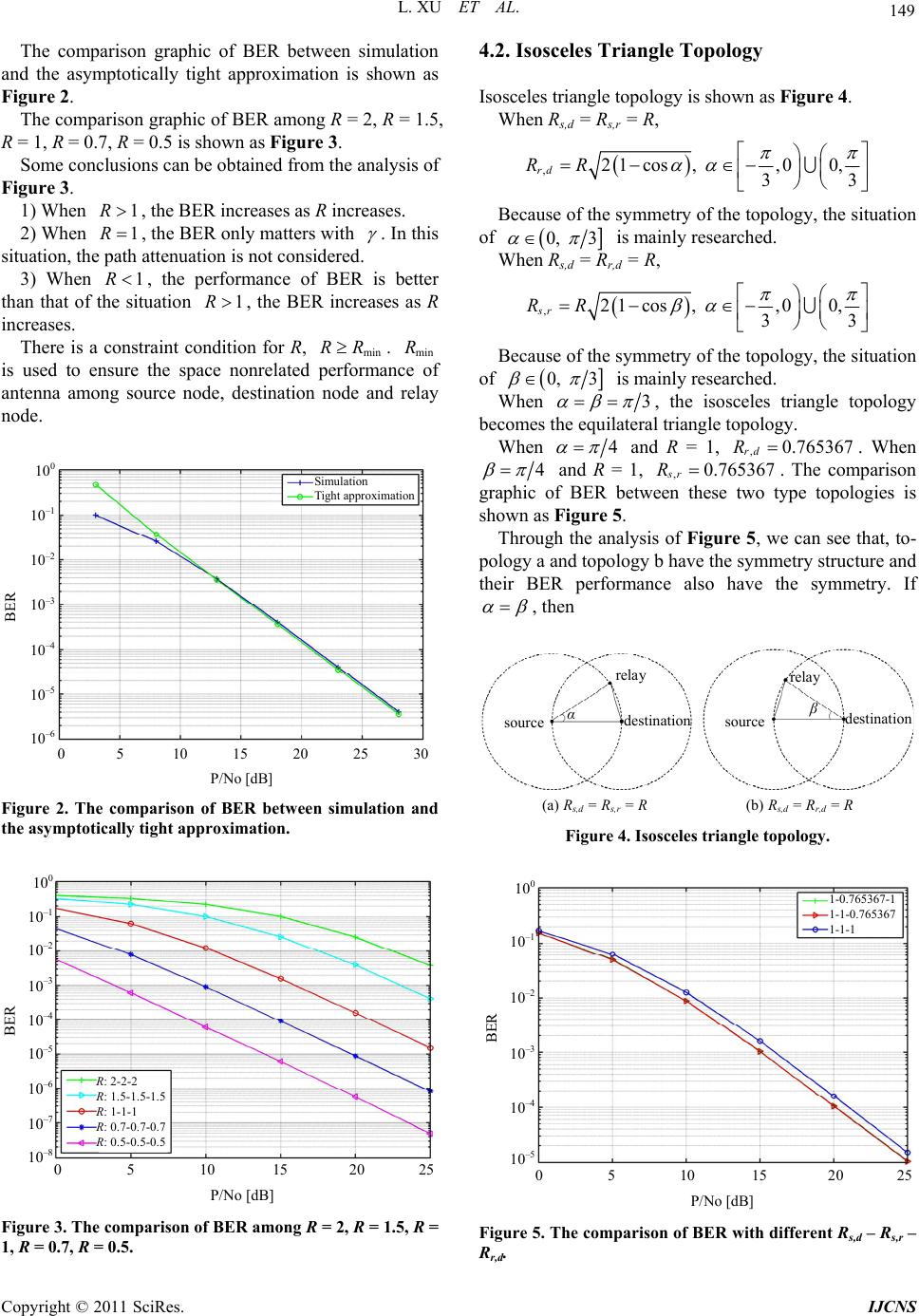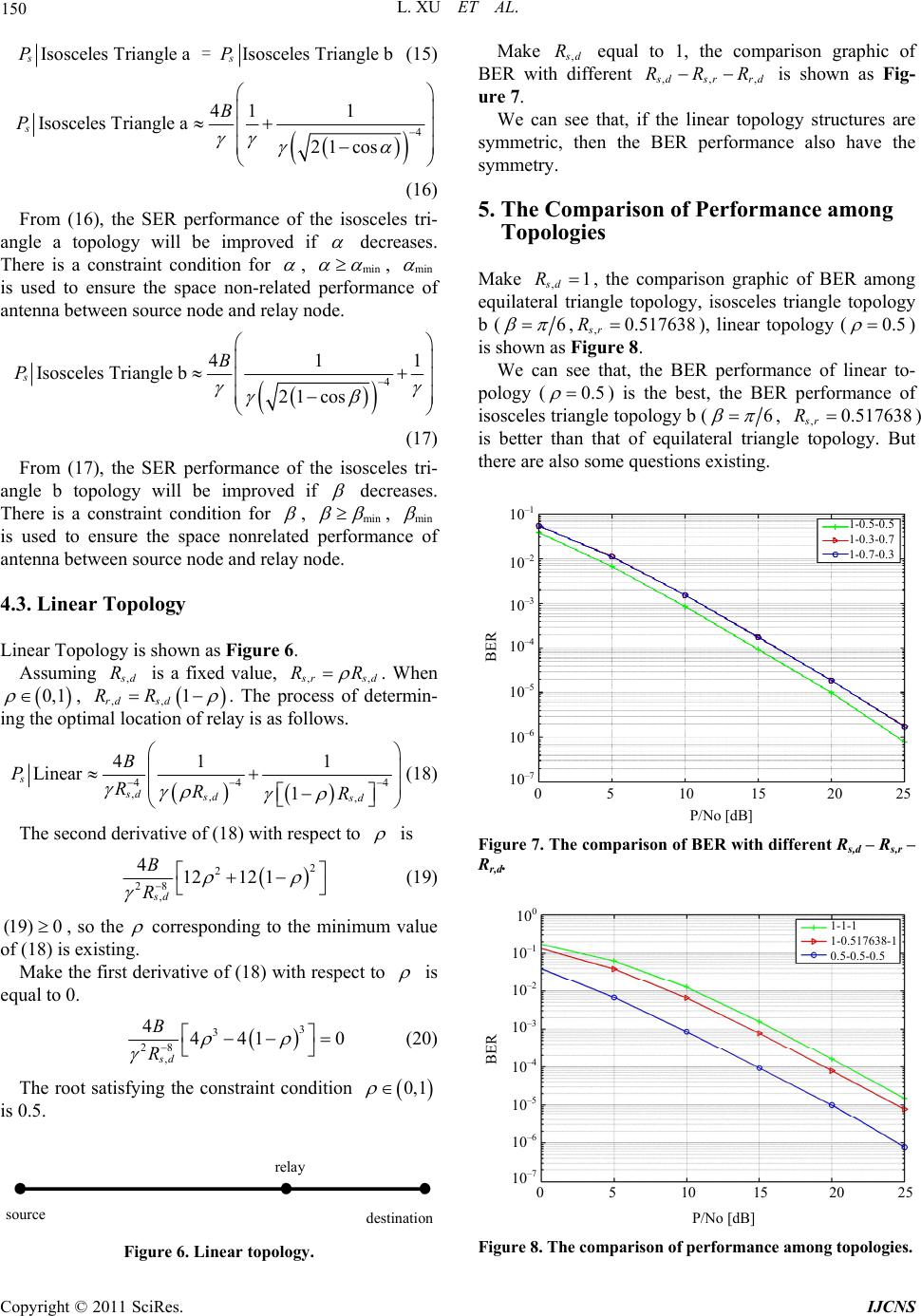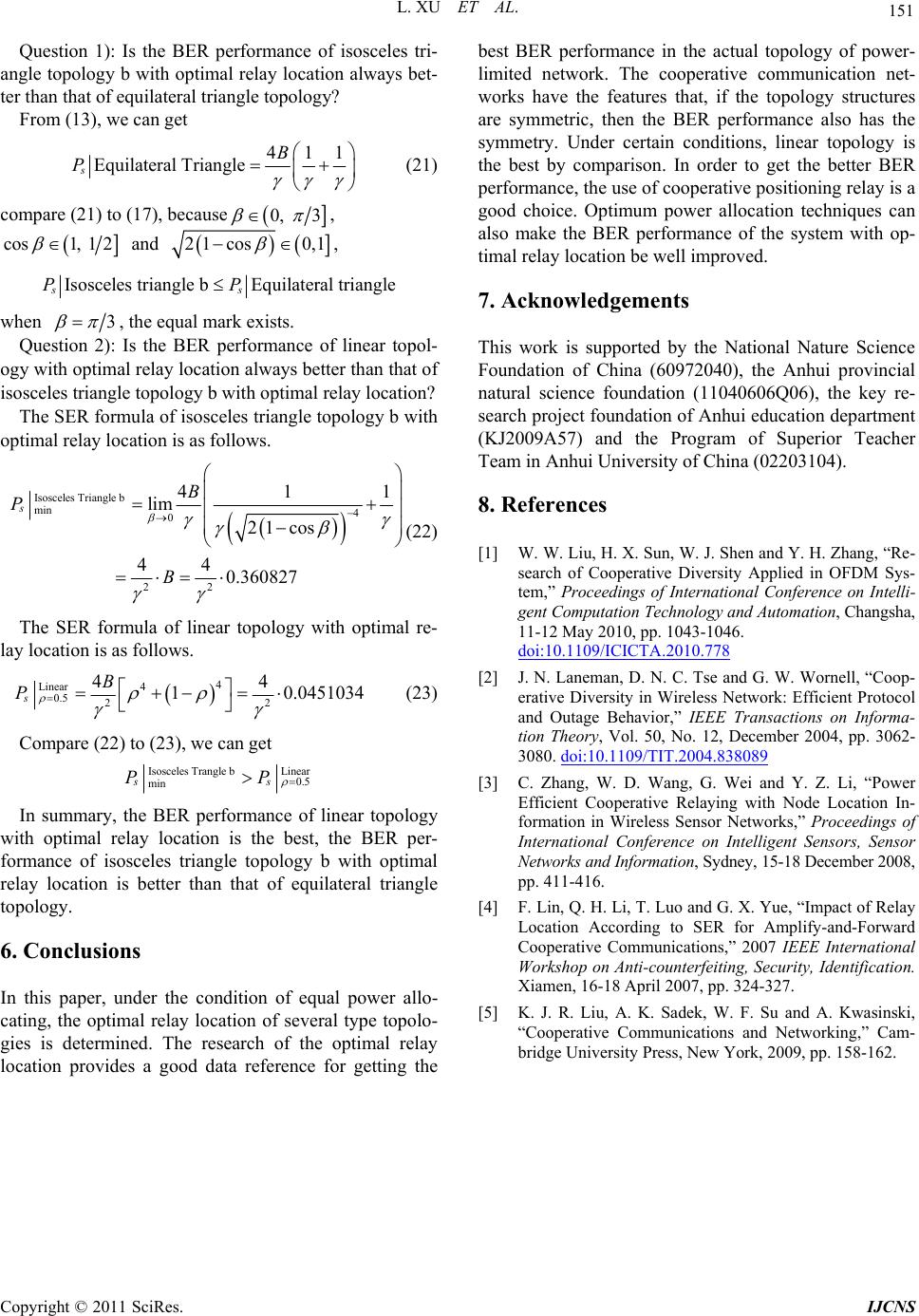 Int. J. Communications, Network and System Sciences, 2011, 4, 147-151 doi:10.4236/ijcns.2011.43018 Published Online March 2011 (http://www.SciRP.org/journal/ijcns) Copyright © 2011 SciRes. IJCNS Optimum Relay Location in Cooperative Communication Networks with Single AF Relay Lei Xu, Hong-Wei Zhang, Xiao-Hui Li*, Xian-Liang Wu The Key Laboratory of Intelligent Computing and Signal Processing, Ministry of Education, Anhui University, Hefei, China E-mail: xhli@ahu.edu.cn Received December 12, 2010; revised January 28, 2011; accepted February 3, 2011 Abstract In recent years cooperative diversity has been widely used in wireless networks. In particular, cooperative communication with a single relay is a simple, practical technology for wireless sensor networks. In this pa- per, we analyze several simple network topologies. Under the condition of equal power allocating, the opti- mum relay location of each network topology are respectively made sure by using symbol error rate (SER) formula. And these types of topologies are compared, the analysis results show that, linear network topology has the best system performance, the system performance of isosceles triangle topology is better than that of equilateral triangle topology. Keywords: Relay Location, Cooperative Communication, AF (Amplify and Forward), Topology 1. Introduction Multiple antennas transmitting diversity technology has been investigated based on their ability to co mbat fading induced by multi-path of the channel, and has been widely used in wireless communication system. However, the deployment of antenna array on mobile terminal is difficult due to the size and power limitation. In order to solve this problem a new mode of gaining transmit di- versity called cooperative diversity has been proposed and widely studied [1]. The terminals share their anten- nas and other resources to create a “virtual array” through distributed transmission and signal processing [2]. Compared with the multi-relay cooperative communi- cation, single-relay cooperative communication has more practical value for wireless sensor networks [3]. The re- search for single-relay cooperative communication net- work topology has great significance for improving the performance of cooperative systems. Paper [4] has pointed out that, the location of relay has an impact on the performance of the system. However, the analytic network topology is single and has not given the theo- retical basis of the optimal relay location. In this paper, what is mainly concerned is that, in the uncoded coop- erative communication system, the position of relay is how to affect the SER performance of the system. Ac- cording to the SER formula of single-relay cooperative communication system [5], in several equal-power allo- cated simple network topologies, the optimal relay loca- tion is trying to be gotten. The comparison system per- formance among these types of network topologies will be done. 2. System Model The block diagram of single-relay cooperative commu- nication system is shown as Figure 1. The mechanism of single-relay cooperative communi- cation is divided into two stages. Both stages use the orthogonal channel, such as TDMA, FDMA, or CDMA. In the first phase, source node sends symbols to the des- tination node; relay node receives the symbols sent from source node at the same time. The received symbols ys,d and ys,r at destination node and relay node, respectively, can be written as ,1, ,sdsd ssd yPhnxnzn (1) ,1, ,srsrssr yPhnxnzn (2) In which xs[n] is the transmitted information; P1 is the transmitted power at the source node; hs,d is the channel coefficients from source n ode to destination node, which can be written as ,,,sdsd sd hnd an , ,sd an can be modeled as a zero mean, complex Gaussian random  148 L. XU ET AL. relay source destination 1 2 h s,r h s,d h r,d Figure 1. Block diagram of single-relay cooperative com- munication system. variable with variances 2 , d , the path loss , d d (as- suming a plane-earth model) is proportional to 2 , d R , , d R is the distance between source node and destination node. , r h he channel coefficients from source node to relay node, which can be written as is t ,,, , srsr sr hnd an ,sr an can be modeled as a zero-mean, complex Gaus- sian random variables with variances 2 , r , the path loss , r d (assua plane-earth modeloportional to 2 , ming ) s pr r R, , r R is the distance between source nodeand re- lay node. ,sd zn and ,sr zn are additive white sian Gaus- noise. In the second phase, relay node amplifies the received signal and forwards it to destination node with transmit- ted power P2. The received symbols at the destination can be written as 2 ,,, 2 1, 0 rdrdsr rd sr P yhny Ph N , zn (3) where ,rd h is the channel coefficients from relay node to destination node, which can be written as ,rd hn ,,rd rd, dan ,rd an can be modeled as a zero-mean, complex Gaussian random variables with variances 2 ,rd , the path loss ,rd (assuming a plane-earth model) is proportional to , ,rd is the distance between source node and relay node. d2 ,rd RR ,rd zn is additive white Gaussian nois e. Assuming the antenna modes used by source node, destination and relay node in the syste m are omni anten- nas. The power of transmitted symbols s n is nor- malized. 2 , d , 2 , r and 2 ,rd are set to 1. 3. Theoretical Analysis THEOREM I: If all of the channel links ,, d h ,, r h0 ,rd are available, i.e., , and rd h2 ,0 sd 2 ,0 sr 2 , , then when 10 PN and 20 PN go to infinity, the SER of the AF systems with M-PSK or M-QAM modulation can be tightly approximated as 2 0 222 2 1, 1,2, 11 1 s sd srrd BN PbP PP (4) where, for M-PSK signal, SK bb for M-PSK and [5] 24 sin sin 31 8432 M M BM (5) In which M = 4, b = 1, and for QPSK modulation adopted in this paper. So, 91 32 4 B 0 is the power value of additive white Gaussian noise for each channel. N When 12 2PPP , P is the fixed total transmission power 1 PPP 2 . Define 12 12 12 000 1 , , , so . 2 PPP NNN 224 1, 1, ,24 2 11,, 00 1 2 sd sd sd4 ,, dsd sdsd Ph PR RR NN (6) 224 2, 2, ,2424 22,, ,, 00 1 2 rd rd rd rd rdrd rd Ph PR RR NN (7) 224 1, 1, ,24 24 31,,,, 00 1 2 sr sr sr rsr srsr Ph PR RR NN (8) With channel model, (4) is transformed as follows through the use of (6), (7) and (8). 44 4 ,, , 411 s sd srrd B PRR R R (9) 4. Topology Models Analysis 4.1. Equilateral Triangle Topology Because ,,,sdsr rd RRR , (9) is transformed as follows. 2 4 8 s B P R (10) The transform relation between bit error rate (BER) and SER b P P is as follows. 11 b Ps P (11) So (10) can be transfo rmed to (12) 2 4 8 11 11 bs B PP R (12) When R = 1, we can get 2 8 s B P (13) 2 8 11 11 bs B PP (14) Copyright © 2011 SciRes. IJCNS  L. XU ET AL. 149 The comparison graphic of BER between simulation and the asymptotically tight approximation is shown as Figure 2. The comparison graphic of BER among R = 2, R = 1.5, R = 1, R = 0.7, R = 0.5 is shown as Figure 3 . Some conclusions can be obtained from the analysis of Figure 3. 1) When , the BER increases as R increases. 1R 2) When , the BER only matters with 1R . In this situation, the path attenuatio n is not considered. 3) When , the performance of BER is better than that of the situation , the BER increases as R increases. 1R1R There is a constraint condition for R, . is used to ensure the space nonrelated performance of antenna among source node, destination node and relay node. min RRmin R Simulation Ti ght approximation P/No dB 0 5 10 15 20 25 30 BER 10 0 10 –1 10 –2 10 –3 10 –4 10 –5 10 –6 Figure 2. The comparison of BER between simulation and the asymptotically tight approximation. : 2-2-2 : 1.5- 1.5-1. 5 : 1-1-1 : 0.7- 0.7-0. 7 : 0.5- 0.5-0. 5 P/No dB 0 5 10 15 20 25 BER 10 0 10 –1 10 –2 10 –3 10 –4 10 –5 10 –6 10 –7 10 –8 Figure 3. The comparison of BER among R = 2, R = 1.5, R = 1, R = 0.7, R = 0.5. 4.2. Isosceles Triangle Topology Isosceles triangle topology is shown as Figure 4. When Rs,d = Rs,r = R, ,21cos, ,00, 33 rd RR Because of the symmetry of the topology, the situation of 0, 3 is mainly researched. When Rs,d = Rr,d = R, ,21cos, ,00, 33 sr RR Because of the symmetry of the topology, the situation of 0, 3 is mainly researched. When 3 , the isosceles triangle topology becomes the equilateral triangle top ology. When 4 and R = 1, . When ,0.765367 rd R 4 and R = 1, ,sr R0.765367 . The comparison graphic of BER between these two type topologies is shown as Figure 5. Through the analysis of Figure 5, we can see that, to- pology a and topology b have the symmetry structure and their BER performance also have the symmetry. If , then relay relay source source destination destination β α (a) Rs,d = Rs,r = R (b) Rs,d = Rr,d = R Figure 4. Isosceles triangle topology. P/No dB 0 5 10 15 20 25 BER 10 0 10 –1 10 –2 10 –3 10 –4 10 –5 1-0.765367-1 1-1-0.765367 1-1-1 Figure 5. The comparison of BER with different Rs,d – Rs,r – Rr,d. Copyright © 2011 SciRes. IJCNS  150 L. XU ET AL. Isosceles Triangle aIsosceles Triangle b ss PP = (15) 4 41 1 Isosceles Triangle a21 cos s B P (16) From (16), the SER performance of the isosceles tri- angle a topology will be improved if decreases. There is a constraint condition for , min , min is used to ensure the space non-related performance of antenna betwe en s o urce node and relay node. 4 41 Isosceles Tri angle b21 cos s B P1 (17) From (17), the SER performance of the isosceles tri- angle b topology will be improved if decreases. There is a constraint condition for , min , min is used to ensure the space nonrelated performance of antenna betwe en s o urce node and relay node. 4.3. Linear Topology Linear Topology is shown as Figure 6. Assuming , d R is a fixed value, ,, r RR sd . When , 0, 1 ,, 1 sd rd RR . The process of determin- ing the optimal location of relay is as follows. 44 ,,, 41 1 Linear 1 s sd sd sd B PRRR 4 (18) The second derivative of (18) with respect to is 2 2 28 , 41212 1 sd B R (19) (19) 0, so the corresponding to the minimum value of (18) is existing. Make the first derivative of (18) with respect to is equal to 0. 3 3 28 , 4441 sd B R 0 (20) The root satisfying the constraint condition 0,1 is 0.5. relay source destination Figure 6. Linear topology. Make , d R equal to 1, the comparison graphic of BER with different ,,, dsrr RRR d is shown as Fig- ure 7. We can see that, if the linear topology structures are symmetric, then the BER performance also have the symmetry. 5. The Comparison of Performance among Topologies Make ,1 sd R , the comparison graphic of BER among equilateral triangle topology, isosceles triangle topology b (6 ,,0.517638 sr R ), linear topology (0.5 ) is shown as Figure 8. We can see that, the BER performance of linear to- pology (0.5 ) is the best, the BER performance of isosceles triangle topology b (6 , ,0.517638 sr R ) is better than that of equilateral triangle topology. But there are also some questions existing. 1-0.5-0.5 1-0.3-0.7 1-0.7-0.3 P/No dB 0 5 10 15 20 25 BER 10 –1 10 –2 10 –3 10 –4 10 –5 10 –6 10 –7 Figure 7. The comparison of BER with different Rs,d – Rs,r – Rr,d. 1-1-1 1-0.517638-1 0.5-0.5-0.5 P/No dB 0 5 10 15 20 2 BER 10 0 10 –1 10 –2 10 –3 10 –4 10 –5 10 –6 10 –7 Figure 8. The comparison of performance among topologies. Copyright © 2011 SciRes. IJCNS  L. XU ET AL. Copyright © 2011 SciRes. IJCNS 151 Question 1): Is the BER performance of isosceles tri- angle topology b with optimal relay location always bet- ter than that of equilateral triangle topo logy? From (13), we can get 411 Equilateral Triangle s B P (21) compare (21) to (17), because 0, 3 , cos1 , 12 and 21 cos0,1 , Isosceles triang le bEquilateral tri angle ss PP when 3 , the equal mark exists. Question 2): Is the BER performance of linear topol- ogy with optimal relay location always better than that o f isosceles triangle topology b with optimal relay location? The SER formula of isosceles triangle topology b with optimal relay location is as follows. Isosceles Triangle b min 4 0 22 41 lim 21 cos 44 0.360827 s B P B 1 (22) The SER formula of linear topology with optimal re- lay location is as follows. 4 Linear 4 0.5 22 44 1 0.0451034 s B P (23) Compare (22) to (23), we can get Isosceles Trangle bLinear 0.5 min ss PP In summary, the BER performance of linear topology with optimal relay location is the best, the BER per- formance of isosceles triangle topology b with optimal relay location is better than that of equilateral triangle topology. 6. Conclusions In this paper, under the condition of equal power allo- cating, the optimal relay location of several type topolo- gies is determined. The research of the optimal relay location provides a good data reference for getting the best BER performance in the actual topology of power- limited network. The cooperative communication net- works have the features that, if the topology structures are symmetric, then the BER performance also has the symmetry. Under certain conditions, linear topology is the best by comparison. In order to get the better BER performance, the use of cooperative position ing relay is a good choice. Optimum power allocation techniques can also make the BER performance of the system with op- timal relay location be well improved. 7. Acknowledgements This work is supported by the National Nature Science Foundation of China (60972040), the Anhui provincial natural science foundation (11040606Q06), the key re- search project foundation of Anhui education department (KJ2009A57) and the Program of Superior Teacher Team in Anhui University of China (022 03104). 8. References [1] W. W. Liu, H. X. Sun, W. J. Shen and Y. H. Zhang, “Re- search of Cooperative Diversity Applied in OFDM Sys- tem,” Proceedings of International Conference on Intelli- gent Computation Technology and Automation, Changsha, 11-12 May 2010, pp. 1043-1046. doi:10.1109/ICICTA.2010.778 [2] J. N. Laneman, D. N. C. Tse and G. W. Wornell, “Coop- erative Diversity in Wireless Network: Efficient Protocol and Outage Behavior,” IEEE Transactions on Informa- tion Theory, Vol. 50, No. 12, December 2004, pp. 3062- 3080. doi:10.1109/TIT.2004.838089 [3] C. Zhang, W. D. Wang, G. Wei and Y. Z. Li, “Power Efficient Cooperative Relaying with Node Location In- formation in Wireless Sensor Networks,” Proceedings of International Conference on Intelligent Sensors, Sensor Networks and Information, Sydney, 15-18 Decemb er 2008, pp. 411-416. [4] F. Lin, Q. H. Li, T. Luo and G. X. Yue, “Impact of Relay Location According to SER for Amplify-and-Forward Cooperative Communications,” 2007 IEEE International Workshop on Anti-counterfeiting, Security, Identification. Xiamen, 16-18 April 2007, pp. 324-327. [5] K. J. R. Liu, A. K. Sadek, W. F. Su and A. Kwasinski, “Cooperative Communications and Networking,” Cam- bridge University Press, New York, 2009, pp. 158-162.
|